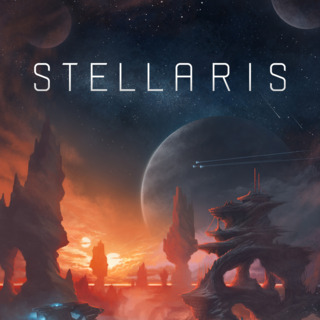INTRO:
Space is vast. Supposedly, much of it is empty – but there is also a lot of room for things to live and even grow in, presumably they are somehow hardened against the vacuum and the perils of open space. This gives rise to the other end of the spectrum of believers who like to think that there are things out there in the great darkmess. Instead of the empyreal wonders and brilliant phenomena that the bright-eyed optimists dream of, the nihilistic pessimists expect gigantic terrors that are the top of the galactic food chain.
Paradox’s developers have such wild imaginations too – wild enough that the first expansion pack to Stellaris is about huge things in space.
LEVIATHANS - OVERVIEW:
The stars of this expansion pack are the eponymous Leviathans. In the history of Stellaris since this expansion, gigantic fleet-wrecking threats have been given the catch-all label “Leviathans”. They are daunting challenges to overcome, but there are lucrative rewards to be had from defeating them.
They are also alternatively called “Guardians”, because they often stay in the star systems that they appeared or spawned in and generally remain there (thankfully). However, they are also likely to thrash anything that gets into their star systems. This also means that they practically act as obstacles to expansion attempts.
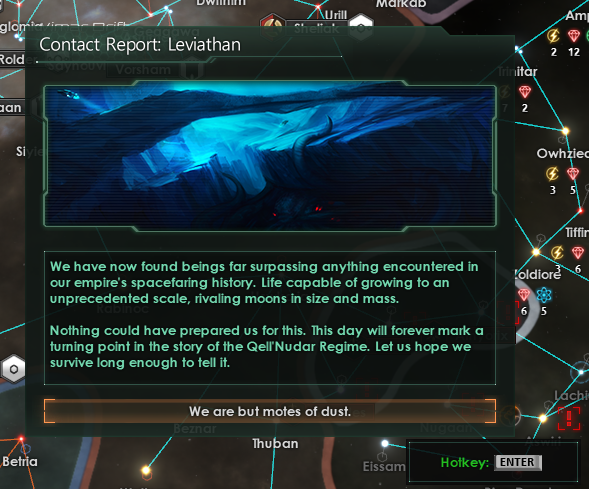
Preferably, the player should do as much research on Leviathans as possible, because of them is quite unique. On the other hand, Leviathans have one common trait: their load-outs cannot be examined at all (the game says that the civilization’s scanners cannot make sense of them). Even at this time of writing, the exact details of most of their load-outs are not clear. However, there is an in-game means of getting tips on how to fight them, which will be described later.
Not all Leviathans will appear in a playthrough. This depends on the size of the galaxy, the complexity of its star system connections and, of course, the density of monsters that the player selected (that is the option that the expansion introduces, by the way). However, the game generally does not include a type of Leviathan more than once.
The Leviathans are mainly there to challenge the player in the mid- to late-game segments of a playthrough. They will test the player’s understanding of fleet compositions and where to launch an attack on them from (there will be more elaboration on this later). Also, despite the ominous in-game descriptions of them, none of them appears to attack planets. They wreck fleets, of course.
There are some noticeable designs about the Leviathans that will be described in their own sections.
MONSTERS WITH MONSTROUSLY LONG RANGES:
There are some Leviathans that appear to be “living” things, or at least not made out of machines. These monsters often have abilities that let them heal or otherwise replenish their durability. For example, the Dimensional Horror is always regenerating itself. In another example, the Ether Drake can always return to its lair (which is practically a planetoid) to heal.
Therefore, any civilization that is out to kill them should be doubly sure about the strength of its navy, because they have to kill them in a single go. Besides, angered space monsters will leave their homes to wreck a few star systems of the civilization that failed to destroy them in an act of retribution (though, again, they do not target planets).
Many of these monstrous Leviathans have exceptionally long-ranged weaponry – in particular, each of them happens to have energy beams that can toast a cruiser outright. Therefore, if the player wants to hunt them down early on, the player might want to consider fleet loadouts that cause the monsters to waste their firepower. (Destroyers are very good for this purpose, but the monsters will eventually target cruisers or battleships, if there are any.)
It might be tempting to use corvettes against them, but many monsters somehow have short-ranged weaponry that can shred corvettes to pieces too. Incidentally though, many of these weapons are outranged by their own energy beams; some monsters like the Stellarite Devourer prefer to use their longer-ranged weapons over the others. In such cases, it might be wiser to beat them at their own long-ranged game by having a fleet that is meant to take losses from their energy beams without losing too much of its own strength.
Speaking of which, most, if not all, monsters make use of energy weapons, so it might be tempting to refit ships with shields. Some of their weapons do penetrate shields, unfortunately.
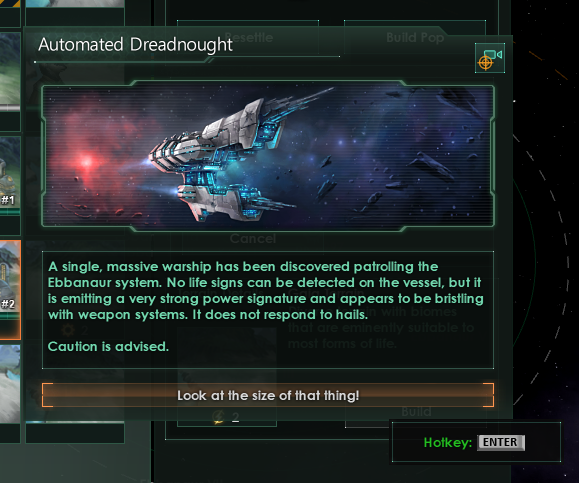
MACHINE LEVIATHANS:
Not all Leviathans are ancient beings that have stood the test of natural selection. Some are relics from the past (or perhaps the future). An example, the Infinity Machine, is shown in one of the examples.
These Leviathans actually have weapons that are found on regular ships, albeit their configurations are unique. Some of them do have special weapons anyway.
Most of the rewards for defeating machine Leviathans are techs. In the case of the Automated Dreadnought, its wreck can be restored, effectively adding a special ship of considerable power to the player’s navy.
RISKS IN ENGAGING LEVIATHANS:
As mentioned earlier, the Leviathans will recognize which civilization has been hurting them. If they are mobile, they will go on rampages to punish their aggressors. This makes things worse, if the civilization has lost ships or fleets in trying to kill them.
That is not the worst risk: the other civilizations are always aware of the civilization’s losses, and some might take the opportunity to turn on it if it could not replace its losses quickly.
ENCLAVES:
The other major piece of content that the expansion introduces are enclaves. These are independent starbases that had been around for a long, long time, thanks to steadfastly geopolitically neutral private enterprising. The Enclaves will not immediately reveal themselves to the civilizations; rather, they usually reveal themselves after some time has passed or a civilization has expanded to a certain distance from them. However, they will reveal themselves if a civilization claims the star system that they are in.
There are three types of Enclaves: Curators, Artisans and Traders. Each of them work differently enough to be explained in their own sections. However, they do have some similarities.
Firstly, the Enclaves are all starbases. They are not going anywhere, and they do not have any navies. If the player so wishes, the player could have them destroyed, just to loot their remains. However, word travels quickly; the other Enclaves would just cease to do business with the player, which can be a big loss (unless of course, the player’s civilization is a genocidal one).
Secondly, all of the Enclaves appear under the list of Contacts, and can be contacted like regular civilizations can be. However, their user interface is entirely different.
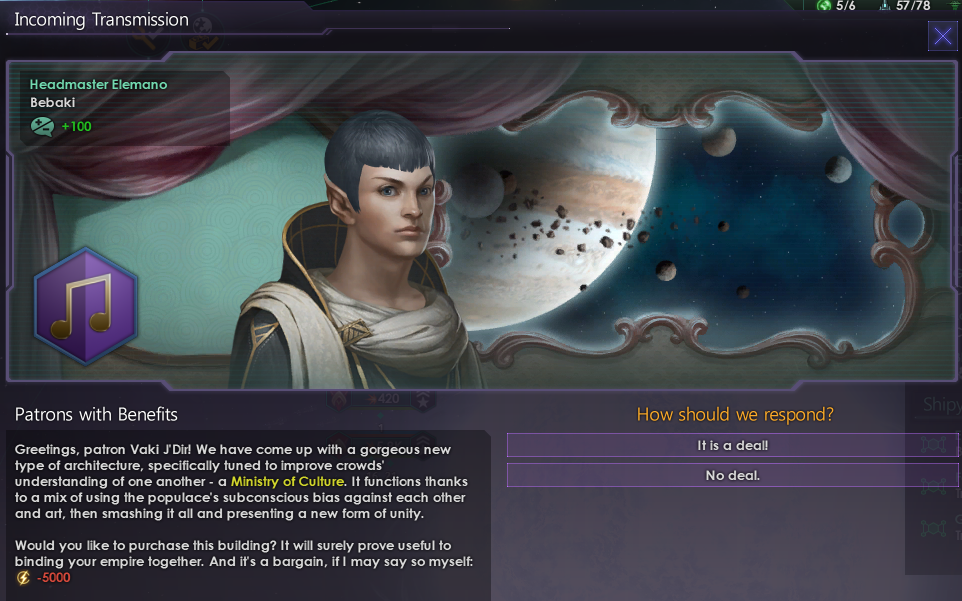
ENCLAVE OPINIONS:
Not all of the services provided by Enclaves are available from the start; these are greyed out. To enable these, the Enclaves’ Opinion of a civilization has to be improved.
Their Opinion ratings work differently from those of regular civilizations. For one, what works for regular civilizations do not work for them at all. There are no trade deals to be made and no diplomatic exchanges to be made; the Enclaves are strictly neutral.
However, their Opinion ratings can be improved by using their services. Eventually, the other options are enabled.
CURATORS:
All Curator Enclaves are linked to each other; communicating with one of them is practically communicating with all of them. The only import of significance about there being multiple Curator Enclaves is the special module that the system owner can add to starbases in the same systems as the Enclaves.
Anyway, Curators, as their name suggests, are collectors of knowledge, and have no problems sharing them given their prices are met; their services are often paid for in Energy credits.
As for what they do, their main purpose is to inform the player of the presence of Leviathans; they can be paid a small (but still significant) fee to reveal the locations of “mysteries of the universe”. These mysteries often turn out to be Leviathans that would outright thrash anything that the player has sent over to find them. It can be unpleasant to learn the hard way that the Curators had not said anything about the danger that the Leviathans pose. (There are other warning signs, of course, if the player is observant enough to notice them; this will be elaborated later.)
Incidentally, since the latest expansion at this time of writing, Distant Stars, introduces more Leviathans, Curator Enclaves are implemented as content in that expansion pack as well so that there is some in-game information about them. There are very few, if any, incompatibilities between the coding for Curator Enclaves in these two expansion packs.
There are some services that the Curators can provide. Each of them has nuances that are not immediately clear and will be described in the following sections.
ADVICE ON LEVIATHANS:
After the player has found the Leviathans (and triggered the message informing the player of their existence), the player can ask the Curators for information and/or advice on them. The lore about the Leviathans is always free, and functions as flavour text. However, the tips on how to fight them are not free, but the tips also impart damage bonuses against the Leviathans (with the exception of one of them). The tips are costly and are only ever useful once (they are useless after the Leviathans have been killed), but they can minimize casualties (by having the Leviathan killed at a faster rate, of course).
However, the option to ask things about a Leviathan is not always there. It would appear that the main prerequisite for this is that the player’s fleets must be able to reach the Leviathan; if there are any closed borders in the way, this won’t happen.
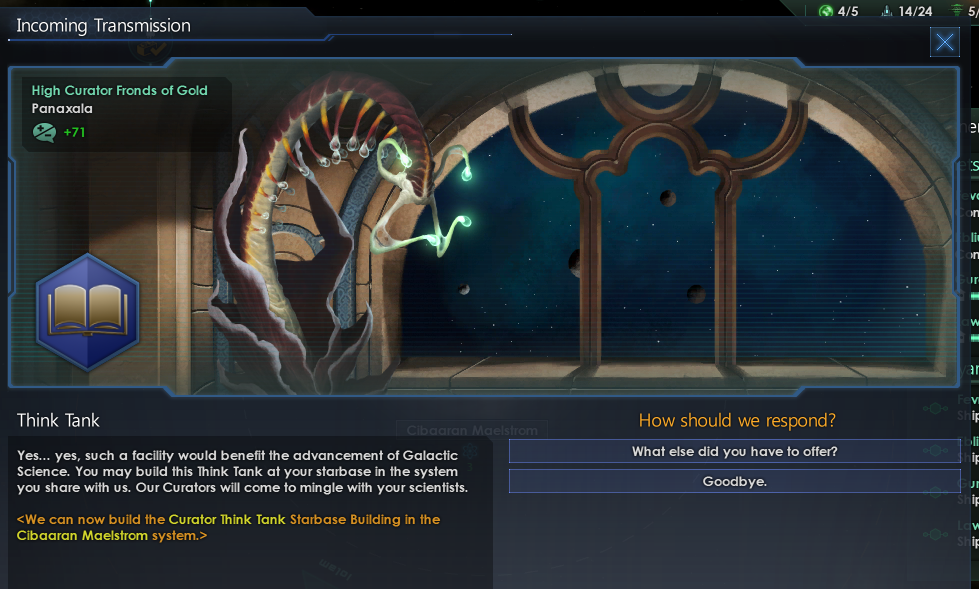
RESEARCH ASSISTANCE:
The Curators are always happy to share their databanks for purposes of research, in return for hefty donations for the maintenance of their assets. This is always a worthwhile investment; all research bonuses are. This paid-for assistance is always there as long as there are Curator Enclaves in the galaxy.
However, the game does not inform the player that the fees that they charge are proportional to the size of their client civilization. Nevertheless, this is an understandable inflation in cost. After all, if a civilization has become able to pay for this, it should be able to pay the rising costs too. Research advantages are no small matter.
CURATOR THINK-TANK:
The main advantage of having the system in which a Curator Enclave resides is the opportunity to install a Curator think-tank module in the upgraded starbase of the system. This grants considerable science points income, and also makes the starbase that much more precious.
CURATOR SCIENTIST LEADER:
Another service that the Curator Enclaves can provide is the hiring-out of a Curator-grade scientist. They will only ever hire out just one to any civilization, though a replacement can be obtained if this one dies. They tend to be long-lived though, if they are not outright synthetic. The scientist is already at level 5 too. The Curator scientist also counts automatically as a specialist in any field, so he/she/it can work on any rare techs without any penalties.
The Curator’s skill and talent is not the only reason to have one. Having the Curator scientist lead the Physics field research can result in the appearance of special options that could not appear otherwise. These are options that would be incredibly useful in the early game, when much of the galaxy is still unexplored.
This curator scientist effectively becomes a leader in the civilization that hired his help; he/she/it is practically an exile, and will not give two hoots if something bad happens to the Curator Enclave.
ARTISAN ENCLAVES:
Like the Curator Enclaves, the Artisan Enclaves are all linked to each other. Functionally, they are there to provide the means to accelerate accumulation of Unity.
The first service that they provide is to have a civilization become one of their patrons. This grants a bonus to the Unity accumulation of that civilization, and also enables the occurrence of occasions when the Artisans approach their patrons asking for help. Helping them gives a civilization precious Influence points. One of these occasions allows their patron to build the Ministry of Culture, a special Empire-unique building that could not be obtained any other way.
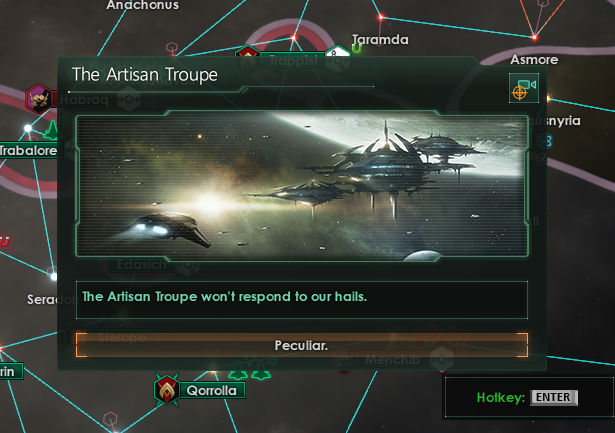
The next service is the creation of art monuments. These are special Planet-unique buildings that generate a lot of Unity, and also improves Migration attraction to the planet that they are on. (On the other hand, the Migration system being the mind-boggling gameplay element that it is, this is not an entirely good bonus.) However, the Artisan Enclaves only allow a patron to have five of the Art Monuments at any time. (The player could abandon a planet that has one, build one more elsewhere, and recolonize that planet to work around this limitation.)
The third service is the organization of festivals, which grant a civilization-wide buff of Happiness and Population Growth that lasts five years. This service can only be done every ten years, however, and there is a chance of something odd occurring while the festivals are going on. One of these occurrences is the reversal of the festivals’ buff, which is of course a case of bad luck. The artisans might also run off with some of the patron’s Energy and Minerals, and freeze communications for 10 years. (They still have the gall to ask for renewals of patronage though.)
Finally, if a civilization controls the star system that has an Artisan Enclave, the starbase can have an art college, which rolls in Unity incomes.
TRADER ENCLAVES:
Trader enclaves allow a civilization to exchange monthly incomes of a resource for those of another resource – at an unfavourable rate of course. Nevertheless, this is a handy way to deal with excesses of resources, if the player could not somehow have the capacity to hoard them or find something good to spend them on.
However, each trader enclave only allows one exchange deal at any time, though the player can end deals and start new ones easily. For the convenience of multiple deals, the player has to find the other trader enclaves.
There are three trader enclaves, but none of them are linked to each other; they are treated as separate contacts. This allows the player to have three deals going on, but on its own, this would have seemed a terrible work-around for whatever limitation that is preventing more complex exchange deals from happening.
Therefore, each of these three enclaves offers a special deal that is only available after their Opinion rating is high enough. This deal concerns a special Strategic Resource that each of them somehow monopolizes. (Of course, none of them will yield their Strategic Resource if their Enclave is destroyed.) By paying a hefty fee, the Trader Enclave provides its strategic resource for ten years.
Incidentally, each Enclave is named after its strategic resource. XuraCorp sells XuraGel, which enhances habitability across any world. The Muutagan Merchant Guild leases Muutagan Crystals, which somehow improves people’s moods. Finally, the Riggan Commerce Exchange sells Riggan Spice, a drug that enhances the fire rates of ships and the damage of armies.
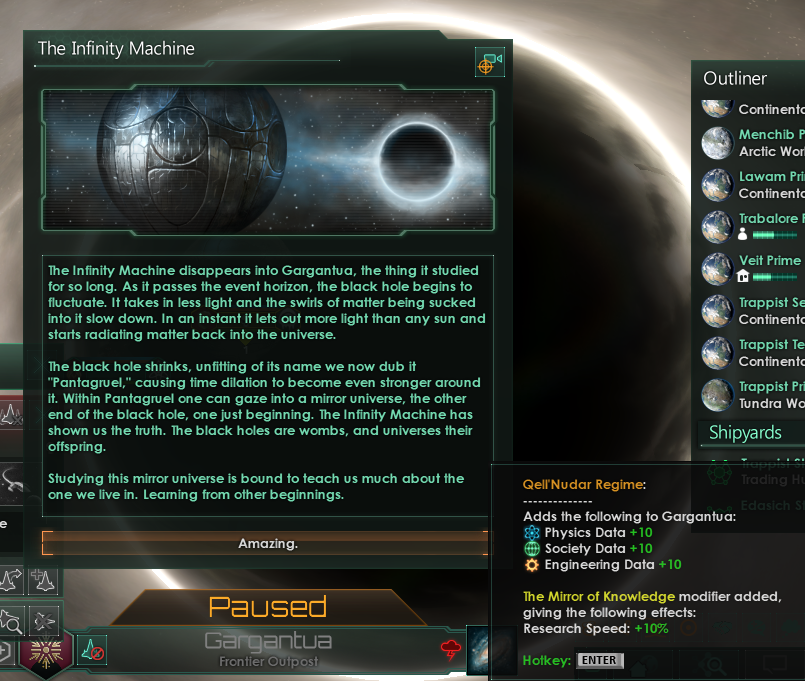
WAR IN HEAVEN:
The expansion introduces one additional complication about Fallen Empires. In the base game, the Fallen Empires may awaken and mess things up for the upstart civilizations, but they otherwise ignore each other, if there are more than one. With Leviathans, there is a chance that if there are two or more Fallen Empires, they might turn on each other over some ancient feud when they awaken. This is the start of the “War in Heaven” campaign.
Once it happens, the Awakened Empires put forth an ultimatum to all upstarts: join them, or else. Joining them immediately sets the civilization as a servant of the Awakened Empire that they joined, but they become a target for the other Awakened Empire (and its servants).
The ones who refuse to bend their knee get to join the “League of Non-Aligned Empires”, which is a special alliance that effectively increases every member’s Opinion ratings of the other members. This is a good chance to build more concrete alliances, especially federations.
Eventually, the War in Heaven would end in the annihilation of one of the Awakened Empires, and possibly its servants as well. The victorious one would turn on the League next, either demanding the bending of the knee, or subjugating by force. Hopefully, the League should be practically a massive Federation by then, with a Federation fleet strong enough to contend with the victor’s remaining (but battle-hardened) assets.
CPU-CONTROLLED CIVILIZATIONS AVOID LEVIATHANS:
Generally, CPU-controlled civilizations always know the locations of Leviathans, and will avoid them until they are packing fleets with power ratings of over 50,000 points. Considering how lousy they are at making decisions, it will be a long, long time before they are confident enough to confront Leviathans.
This is one way to guess the locations of Leviathans (and to realize that the “mysteries” that the Curator Enclaves told the player about are none other); the CPU-controlled civilizations avoid claiming the star systems in their territories that happen to have them.
STILL NO SLAVE TRADE:
With the introduction of Enclaves, one would think that there might be an opportunity to implement a slave trade system, but there still isn’t any, at least not officially.
There is a fan-made mod that introduces a slave-trading Enclave, but it reveals its problems almost immediately: balance issues (in addition to coding problems). Being able to purchase slaves of the same species as other civilizations gives civilizations that practice slavery a considerable leg-up in colonizing planets of different climes. There are attempts to balance this mod, but the perils to gameplay have already been demonstrated.
NO ENCLAVE INTERACTIONS FOR GENOCIDAL CIVILIZATIONS:
None of the Enclaves would have normal interactions with genocidal civilizations, like the Fanatic Purifiers (though these were introduced only in the Utopia expansion). Furthermore, many of the options for dealing with Leviathans are disabled. This means that these civilizations do not benefit as much as the others from the content of this expansion.
Furthermore, not having access to the powerful buffs provided by the Enclaves means that they risk falling behind the others. Of course, such civilizations could just do what they do best: destroy the Enclaves for being anyone other than them. This denies the Enclave’s services to the other civilizations anyway, thus evening the odds.
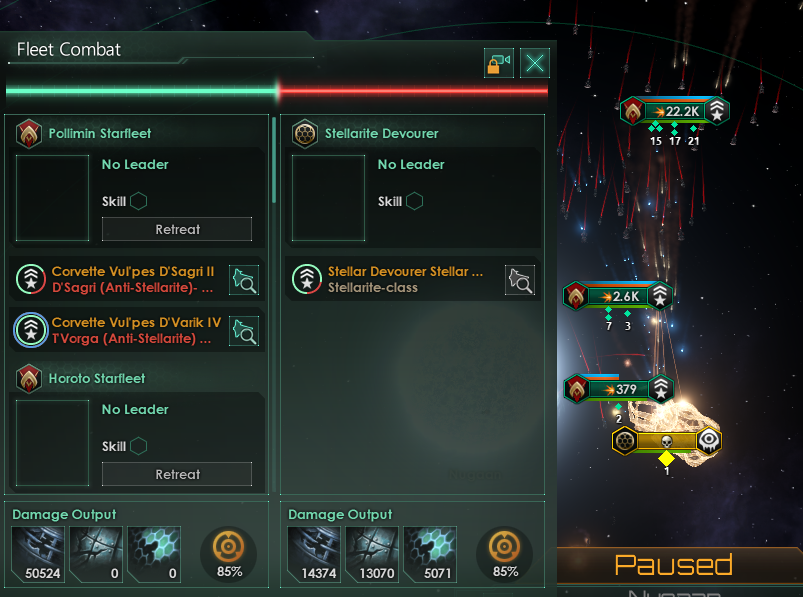
MORE EASTER EGGS:
Stellaris’s designers just love Easter Eggs. Most, if not all of the content in Leviathans has a reference or two, and sometimes to things that are not science fiction. Some of these have been shown in the screenshots, such as the black hole Gargantua that is renamed to Pantagruel if the player followed the peaceful line of the Infinity Machine story. (In this example, the reference is to a certain classical French satire that was heavily suppressed during its debut in sixteenth century A.D.)
There are a couple of references to H.P. Lovecraft’s works too. Indeed, one of the Leviathans is practically a knock-off of a “Great Old One” (possibly Dagon, albeit with too many limbs).
The writing for interactions with the Artisan Enclaves references present-day means for independent artists to get funding, such as Kickstarter and Patreon. As for the “War in Heaven”, it is likely a reference to the Cold War, an era in which there was a Non-Aligned Movement.
VISUAL DESIGNS:
The Enclaves use slightly different-looking starbases and they have different backdrops for their user interface screens. However, that is all there is to their visuals. The icons for the starbase modules that are associated with them are quite bland, and their animated portraits are picked from whatever packages that have been installed for the game.
The visual highlights of the game are, of course, the Leviathans. They are as impressive as they look in the official artwork of the game, though the player should not expect them to be lavishly animated. For example, the Dimensional Horror has many limbs, but they just sway around independently of each other. In another example, the Stellarite Devourer is described as being able to eat stars, but this is never animated. As for the weapons that they use, they have particle effects that are similar to those in the base game.
How they go out when they are slain is also disappointing. Their models appear to disintegrate, their textures burning away to remove any trace that they were there. They do, however, leave baubles behind, and these have models of their own.
This expansion also introduces a set of animated portraits – the “Cuties” pack. Incidentally, many of them look a lot like the critters from a certain Nintendo IP.
SOUND DESIGNS:
Unrecognizable and unearthly sounds accompany the Leviathans, especially the monstrous ones. These can be heard if the player zooms the camera into them. As for the other noises that the expansion introduces, they are the sound effects that accompany the weapons discharge of the monstrous Leviathans. However, since most of them are energy weapons, the sound effects are the usual sizzling, zinging and other onomatopoeic adverbs that are associated with outlandish sci-fi weapons.
The aforementioned “Cuties” animated portraits also come with their own ‘voice-overs’ – some of which strongly suggest that they are inspired by the aforementioned Nintendo IP.
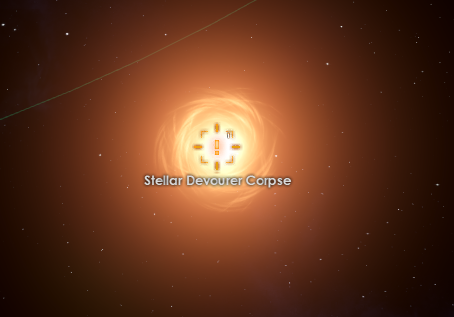
CONCLUSION:
Leviathans is not entirely a step in the right direction for Stellaris in matters of fixing what was (and still is) problematic in the game. Furthermore, the lack of diverse experiences for genocidal empires (later introduced in Utopia)is felt more with the implementation of this expansion’s content. Yet, the content that it introduces does make the mid-game segments more interesting and gives more reasons to go out and explore the galaxy, and the rewards for overcoming the challenges are quite gratifying.
